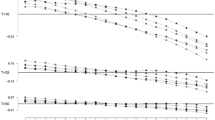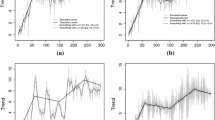Abstract
The conventional first-order autocorrelationcoefficient r1 generates an empiricalbias when it is applied to short time series.The properties of this estimator have beenexamined with a Monte Carlo simulation studyusing the MATLAB program (version5.2). This study also analyzes the functionof the empirical bias with the polynomicregression and derives a polynomic fittingmodel for different sample sizes. In thisway, a new estimator that has been correctedby the absolute value of the fitting model(r1') is proposed. Having analyzed thestatistical properties of the estimator r1',it is shown that the empirical bias generatedby r1' is less in relationship to r1 andr1+. The results of the study make itpossible to verify that the mean squared errorassociated to the estimator r1 isless than that of r1. Thus, the coefficient r1'is recommended to estimate the lag-oneautocorrelation coefficient in samples under 50observations.
Similar content being viewed by others
References
Anderson, R. L. (1942). Distribution of the serial correlation coefficient. Annals of Mathematical Statistics 13: 1-13.
Arnau, J. (1999). Reducció n del sesgo en la estimació n de la autocorrelació n en series temporales cortas. Metodología de las Ciencias del Comportamiento 1: 25-37.
Arnau, J. & Bono, R. (1998). Short time series analysis: C statistic vs Edgington model. Quality and Quantity 32: 63-75.
Bartlett, M. S. (1946). On the theoretical specification and sampling properties of autocorrelated time-series. Journal of the Royal Statistical Society 8: 27-41.
Bono, R. (1995). Diseñ os de series temporales interrumpidas: técnicas alternativas de análisis. Doctoral dissertation. Barcelona: Publicacions Universitat de Barcelona.
Bono, R. & Arnau, J. (1996). C statistic power analysis through simulation. Psicothema 8: 699-708.
Bono, R.& Arnau, J. (1997). Statistic C: Application to behavioral designs. Revista Latinoamericana de Psicología 29: 49-63.
Bono, R. & Arnau, J. (1998). Estadístico C: descripció n y aplicació n a diseñ os de caso ú nico. Psicoló gica 19: 27-40.
Busk, P. L. & Marascuilo, L. A. (1988). Autocorrelation in single-subject research: A counterargument to the myth of no autocorrelation. Behavioral Assessment 10: 229-242.
DeCarlo, L. T. & Tryon, W.W. (1993). Estimating and testing autocorrelation with small samples: A comparison of the C-statistic to a modified estimator. Behavior Research Theory 31: 781-788.
Dixon, W. J. (1944). Further contributions to the problem of serial correlation. Annals of Mathematical Statistics 15: 119-144.
Forsythe, G. E., Malcolm, M. A. & Moler, C. B. (1977). Computer Methods for Mathematical Computations. Englewood Cliffs, NJ: Prentice Hall.
Fuller, W. A. (1976). Introduction to Statistical Time Series. New York: John Wiley.
Gentile, J. R., Roden, A. H. & Klein, R. D. (1972). An analysis-of-variance model for the intrasubject replication design. Journal of Applied Behavior Analysis 5: 193-198.
Glass, G. V., Willson, V. L. & Gottman, J. M. (1975). Design and Analysis of Time Series Experiments. Boulder: Colorado Associated University Press.
Gottman, J. M. (1981). Time-series Analysis: A Comprehensive Introduction for Social Scientists. Cambridge, England: Cambridge University Press.
Greenwood, K. M. & Matyas, T. A. (1990). Problems with the application of interrupted time series analysis for brief single-subject data. Behavioral Assessment 12: 355-370.
Harrop, J. W. & Velicer, W. F. (1985). A comparison of alternative approaches to the analysis of interrupted time-series. Multivariate Behavioral Research 20: 27-44.
Hartmann, D. P. (1974). Forcing square pegs into round holes: Some comments on an analysis of variance model for the intrasubject design. Journal of Applied Behavior Analysis 7: 635-638.
Hartmann, D. P., Gottman, J.M., Jones, R. R., Gardner, W., Kazdin, A. E. & Vaught, R. S. (1980). Interrupted time-series analysis and its application to behavioral data. Journal of Applied Behavior Analysis 13: 543-559.
Huitema, B. E. (1985). Autocorrelation in applied behavior analysis: A myth. Behavioral Assessment 7: 107-118.
Huitema, B. E. (1986). Autocorrelation in behavior modification data:Wherefore art thou?. In A. Poling & R.W. Fuqua (eds), Research Methods in Applied Behavior Analysis: Issues and Advances. New York: Plenum Press, pp. 187-208.
Huitema, B. E. (1988). Autocorrelation: 10 years of confusion. Behavioral Assessment 10: 253-294.
Huitema, B. E. & McKean, J. W. (1991). Autocorrelation estimation and inference with small samples. Psychological Bulletin 110: 291-304.
Huitema, B. E. & McKean, J. W. (1994a). Reduced bias autocorrelation estimation: three jackknife methods. Educational and Psychological Measurement 54: 654-665.
Huitema, B. E. & McKean, J.W. (1994b). Two reduced-bias autocorrelation estimators: r F1 and r F2. Perceptual and Motor Skills 78: 323-330.
Huitema, B. E. & McKean, J. W. (1994c). Tests of H0: ρ1 = 0 for autocorrelation estimators r F1 and r F2. Perceptual and Motor Skills 78: 331-336.
Huitema, B. E. & McKean, J. W. (1996). Tests for the jackknife autocorrelation estimator r Q2. Educational and Psychological Measurement 56: 232-240.
International Mathematical and Statistical Libraries, Inc. (1989). IMSL Library 3. Houston, TX: Author.
Jones, R. R., Vaught, R. S. & Weinrott, M. (1977). Time-series analysis in operant research. Journal of Applied Behavior Analysis 10: 151-166.
Kendall, M. G. (1954). Note on bias in the estimation of autocorrelation. Biometrika 41: 403-404.
Keselman, H. J. & Leventhal, L. (1974). Concerning the statistical procedures enumerated by Gentile et al.: Another perspective. Journal of Applied Behavior Analysis 7: 643-645.
Kratochwill, T. R., Aldin, K., Demuth, D., Dawson, D. L., Panicucci, C., Arnston, P., McMurray, N., Hempstead, J. & Levin, J. (1974). A further consideration in the application of an analysis-ofvariance model for the intrasubject replication design. Journal of Applied Behavior Analysis 7: 629-634.
Marriott, F. H. C. & Pope, J. A. (1954). Bias in the estimation of autocorrelation. Biometrika 41: 390-402.
MATLAB. (1998). The Language of Technical Computing (version 5.2). Natick, MA: The Math-Works, Inc.
Matyas, T. A. & Greenwood, K. M. (1991). Problems in the estimation of autocorrelation in brief time series and some implications for behavioral data. Behavioral Assessment 13: 137-157.
McCleary, R. & Hay, R. A., Jr. (1980). Applied Time Series Analysis for the Social Sciences. Beverly Hills, CA: Sage.
McKean, J. W. & Huitema, B. E. (1993). Small sample properties of the Spearman autocorrelation estimator. Perceptual and Motor Skills 76: 384-386.
Moran, P. A. P. (1948). Some theorems on Time Series II. The significance of the serial correlation coefficient. Biometrika 35: 255-260.
SAS Institute Inc. (1990). SAS Language: Reference (version 6, First Ed.). Cary, NC: Author.
Scheffé, H. (1959). The Analysis of Variance. New York: Wiley.
Sharpley, C. F. & Alavosius, M. P. (1988). Autocorrelation in behavioral data: An alternative perspective. Behavioral Assessment 10: 243-251.
Shine, L. C. & Bower, S. M. (1971). A one-way analysis of variance for single-subject designs. Educational and Psychological Measurement 31: 105-113.
Simonton, D. K. (1977). Cross-sectional time-series experiments: Some suggested statistical analyses. Psychological Bulletin 84: 489-502.
Suen, H. K. (1987). On the epistemology of autocorrelation in applied behavior analysis. Behavioral Assessment 9: 113-124.
Suen, H. K. & Ary, D. (1987). Autocorrelation in applied behavior analysis: Myth or reality?. Behavioral Assessment 9: 125-130.
Thorensen, C. E. & Elashoff, J. D. (1974). An analysis of variance model for intrasubject replication design: Some additional comments. Journal of Applied Behavior Analysis 7: 639-641.
Velicer, W. F. & Harrop, J. W. (1983). The reliability and accuracy of the time-series model identification. Evaluation Review 7: 551-560.
Velicer, W. F. & McDonald, R. P. (1984). Time series analysis without model identification. Multivariate Behavioral Research 19: 33-47.
Velicer, W. F. & McDonald, R. P. (1991). Cross-sectional time series designs: A general transformation approach. Multivariate Behavioral Research 26: 247-254.
Author information
Authors and Affiliations
Rights and permissions
About this article
Cite this article
Arnau, J., Bono, R. Autocorrelation and Bias in Short Time Series: An Alternative Estimator. Quality & Quantity 35, 365–387 (2001). https://doi.org/10.1023/A:1012223430234
Issue Date:
DOI: https://doi.org/10.1023/A:1012223430234




